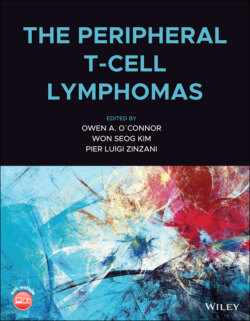Читать книгу The Peripheral T-Cell Lymphomas - Группа авторов - Страница 95
Epidemiology
ОглавлениеPTCLs are a usually clinically aggressive, relatively rare, and heterogeneous group of lymphomas. They constitute about 10–15% of all NHL in the Western countries and 15–20% of all NHLs in Asia [8]. They originate from clonal proliferation of mature post‐thymic lymphocytes. NK‐cell lymphomas are also considered part of the group as NK cells are closely related to T cells. The incidence and prevalence varies in different racial populations and geographical regions [9–11], largely due to host genetic and environmental makeup and prevalence of risk factors, including diseases affecting immunity and virus epidemiology [11].
In an attempt to study the geographical distribution of NHL subtypes, the International NHL Classification Project was conducted in the late 1990s [8]. A total of 1403 cases diagnosed from 1988 to 1990 were included from eight different geographic regions and nine institutions. Of these, 1378 were confirmed to be NHL and were analyzed; 109 cases of PTCL were included (9.4% of 1378), of which 33 were ALCLs. It was found that there were substantial geographical differences in distribution across different types of NHL. A higher percentage of PTCLs were seen in Hong Kong (10%), Cape Town (8%), and London (8%). The incidence in other geographical locations ranged from 1% to 6%. Non‐anaplastic PTCLs (96/129 cases) also revealed geographical variation ranging from 18.3% in Hong Kong to 1.5% in Vancouver. Angiocentric nasal T/NK‐cell lymphomas were almost exclusively seen in Hong Kong (8%) [12].
Subsequently, published in 2008 and confirming the results reported by NHL classification project in regards to differences in geographical distribution of various PTCL subtypes, the International T‐cell Lymphoma Project reported data on 1314 cases of PTCL/NK‐cell lymphomas from 22 centers worldwide with diagnoses between 1990 and 2002. ATLL and NK T‐cell lymphomas were more frequent in Asia (25% and 22.4%, respectively) compared with Europe (1% and 4.3%, respectively) and North America (2% and 5.1%, respectively). In Europe and North America, PTCL‐NOS was the most common subtype (34.3% and 34.5%, respectively). AITL and enteropathy‐associated T‐cell lymphomas (EATL) were more common in Europe compared with North America and Asia, whereas ALK+ ALCLs were most common in North America [10].
In the United States (US), the incidence of T cell lymphomas has been gradually increasing over the past two decades, whereas the incidence of B‐cell lymphomas has plateaued. According to a review of US surveillance, epidemiology and end results cancer database, over a 10‐year period from 2007 to 2016, the incidence rate of T‐cell lymphomas is 2.2 (2.2/1000 patients). Among the T cell lymphomas, PTCLs had the highest incidence (1.2), followed by CTCL (0.6). PTCL‐NOS was the most common subtype of PTCL (0.4), followed by ATLL (0.3), ALCL (0.2), and AITL (0.2). The international PTCL project reported the most common subtypes of nodal T‐cell lymphoma to be PTCL‐NOS (25.9%), AITL (18.5%), ALCL (12%), NK/T‐cell lymphoma (10.4%), hepatosplenic T‐cell lymphoma (HSTL; 1.4%) and subcutaneous panniculitis‐like T‐cell lymphoma (0.9%) [13].
In this chapter, we discuss the epidemiological data for each of the individual subtype of PTCL (Table 5.1).
